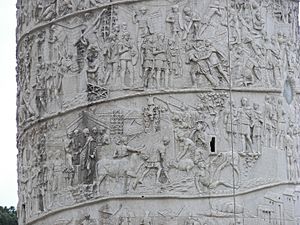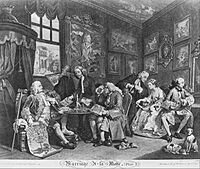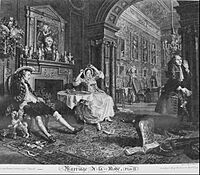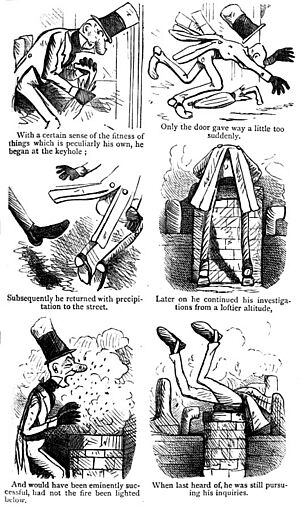History of comics facts for kids
Comics have a long and interesting history! They started in different ways all over the world. You can find early examples of storytelling with pictures in ancient times, like on Trajan's Column in Rome, in Egyptian hieroglyphs, and even on the famous Bayeux Tapestry.
Contents
Ancient Storytelling Through Art
Long ago, people told stories using pictures. You can see this in Egyptian hieroglyphs, on Greek carvings called friezes, and on Rome's Trajan's Column. The column, built in 110 AD, shows a story winding around it.
Other examples include Maya script and old tapestries like the Bayeux Tapestry. In medieval times, artists would paint many scenes from one story, often from the Bible, all in the same picture.
In ancient India, people called "picture showmen" would tell stories while showing painted pictures. This might have started as early as 700 BCE!
For comics to reach many people, modern printing had to be invented. This made comics a way to share stories with everyone.
Early Printed Pictures and Cartoons
Before the 1900s, printed materials often focused on religious topics. Books like the Biblia pauperum had many pictures with text. They helped teach Christianity to people who could not read.
By the 1600s and 1700s, prints started to show political and social life. They also began to make fun of things through satire and caricature. Sometimes, prints would have several images to tell a story. For example, Frans Hogenberg showed scenes from the Spanish Fury in 1576.
One of the first British artists to create picture stories was William Hogarth (1697–1764). He made seven sets of pictures about "Modern Moral Subjects." His work A Rake's Progress had eight pictures that told a story.
As printing got better, thanks to the industrial revolution, magazines and newspapers became popular. These often used drawings to comment on politics and society. These drawings became known as "cartoons" in 1842.
Early works like A True Narrative of the Horrid Hellish Popish Plot (around 1682) by Francis Barlow and A Rake's Progress by William Hogarth (1726) told stories over several images. But it was not until the 1800s that these ideas really came together to form the comic strip.
How Speech Balloons Developed
The idea of a speech balloon also changed over hundreds of years. In medieval times, artists used phylacters. These were like scrolls that named a character or explained their purpose.
Later, artists like George Cruikshank helped turn these scrolls into balloons. At first, they were still called labels. They showed what was happening, but not usually what characters were saying. Artists then stopped using them, putting dialogue below the pictures instead. Speech balloons for talking were brought back later by Richard F. Outcault.
Comics Take Shape
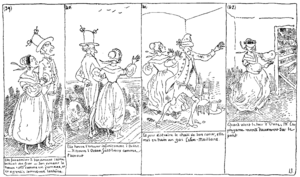
The Glasgow Looking Glass, published in 1826, might have been the first comic magazine. It was a funny magazine that made fun of fashion and politics. It had many things we see in modern comics today. This included pictures with captions that told a story over time, often in parts. It also used speech bubbles, satire, and funny drawings.
Rodolphe Töpffer, an artist from Switzerland who spoke French, was very important in the early 1800s. Töpffer's stories had pictures with text below them. They were printed all over Europe. In 1837, he published Histoire de Mr. Vieux Bois. This was also printed in the United States in 1842 as The Adventures of Obadiah Oldbuck.
Because there were no copyright laws then, many copied versions were made. These copied and translated versions helped create a market for similar works. In 1845, Töpffer wrote about his ideas for "picture stories" (histoire en estampes). He said that making a picture story means inventing a kind of play where all the parts fit together to make a whole story.
In 1845, the funny drawings in newspapers and magazines got a new name: cartoons. The British magazine Punch, started in 1841, called its funny drawings "cartoons." They did this to make fun of the Parliament, who were showing their own "cartoons" (which were actually big drawings for paintings). This new use of the word "cartoon" stuck and is still used today.
Other similar magazines with cartoons in Europe included Fliegende Blätter and Le Charivari. In the U.S., Judge and Puck were popular.
In 1865, Max and Moritz by Wilhelm Busch was published in a German newspaper. Busch made the way sequential art worked even better. His work was a big influence. For example, Rudolph Dirks was inspired by it to create The Katzenjammer Kids in 1897.
First Comics for Many Readers
The first weekly comic with a regular character was Ally Sloper's Half Holiday. It first appeared in the British magazine Judy in 1867. It was created by C. H. Ross and drawn by his French wife Émilie de Tessier.
In 1884, the very popular character Ally Sloper got his own comic magazine. It was called Ally Sloper's Half Holiday and was published by Dalziel Brothers. It had eight pages, was printed in black and white, and was very popular with the working class. It may have sold as many as 350,000 copies! In 1890, two more comic magazines, Comic Cuts and Illustrated Chips, started in Britain. This began the tradition of the British comic as a magazine with many different comic strips.
In the United States, R. F. Outcault combined speech balloons and pictures in his work Hogan's Alley and The Yellow Kid (starting in 1895). Many people say this helped create the modern comic strip. While some earlier works also used speech bubbles and multiple pictures, Outcault's work was very popular. Its place in newspapers helped make the comic strip what it is today.
Comics Become a Mass Medium in the 1900s
The 1920s and 1930s saw comics become even more popular. In Britain, comic magazines like The Dandy and The Beano started to focus on funny stories for children.
In 1929, Hergé created Adventures of Tintin for a Belgian newspaper comic section. These stories were later collected into comic albums, which became very popular. This created a market for more such books.
At the same time in the United States, newspaper comic strips started to tell more than just funny stories. They began to feature action-adventure and mystery stories. These stories were also collected into books. The Funnies, a collection of newspaper strips, was published in 1929.
Soon, a market for comic books grew. The first modern American-style comic book, Famous Funnies: A Carnival of Comics, came out in the U.S. in 1933. By 1938, publishers were printing new stories in this format. This is when Action Comics #1 was launched, with Superman on the cover. Superman's popularity quickly made superhero comics the most important type of American comic book. This type of comic lost some popularity in the 1950s but became very popular again from the 1960s until the late 1900s.
Comics Around the World
In Japan, a country with a long history of art, comics became hugely popular. Japanese comics are called manga. After World War II, Osamu Tezuka helped shape modern manga. He made comics with hundreds of pages and developed a movie-like style. This style was greatly influenced by Disney cartoons of that time.
The Japanese manga market grew to include many types of stories. These ranged from children's fantasy to romance and adult stories. Japanese manga is usually published in large books with hundreds of pages. These stories have often been turned into animated films, called anime in Japan. Many creators work on both manga and anime at the same time, linking the two forms closely.
In the second half of the 1900s, comics became very popular for collectors. From the 1970s, American comic publishers started to encourage collecting. They made many comics specifically for collectors.
The word "comic" can be confusing. It can mean a funny story, or it can mean the whole art form. In the 1960s and 1970s, underground artists used the spelling comix to show their work was different. Their comics were for adults and often funny, so the "comic" label still fit. The term graphic novel became popular in the late 1970s. It was used to make these longer, more serious comic books sound different from regular "comics."
In the 1980s, people started studying comics more seriously in the U.S. Comics also became popular again. Alan Moore and Frank Miller created famous superhero comics. Also, Calvin & Hobbes by Bill Watterson and The Far Side by Gary Larson became very popular newspaper comic strips.
Webcomics and Digital Art
Webcomics have become very popular since the mid-1990s. With the start of the World Wide Web, artists could publish comics online cheaply. Websites like Keenspot and Modern Tales were made just for webcomics. They allowed webcomics to be shared widely.
In 2000, Scott McCloud explained how online comics could change the art form. Artists could use the digital space to create new things, like the "infinite canvas" where a comic never ends. Webcomics became even more common in the early 2000s. Important awards like the Eagle and Eisner Awards started adding categories for digital comics.
See also
 In Spanish: Historia de la historieta para niños
In Spanish: Historia de la historieta para niños
- Comics historiography
- History of American comics
- History of animation
- History of anime
- History of Franco-Belgian comics
- History of manga
- List of years in comics


